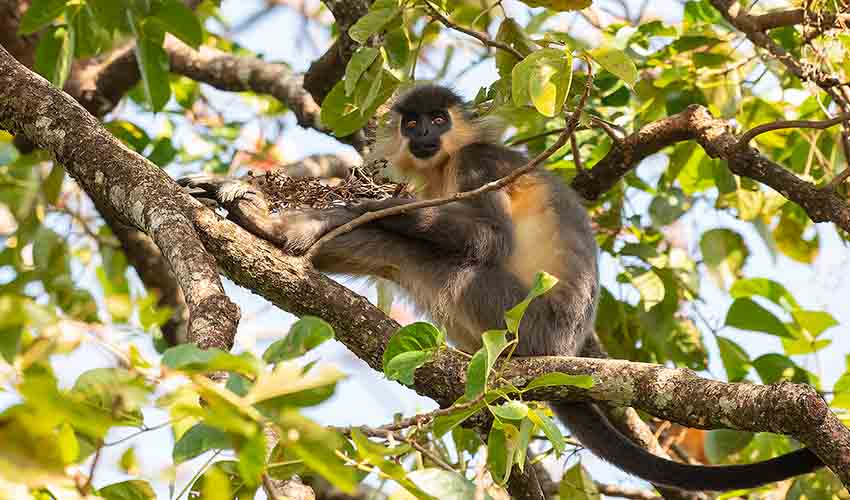Found in northeastern India, Bangladesh, Bhutan, and parts of Myanmar, this langur inhabits subtropical and temperate forests, often in hilly or mountainous terrain. Its most distinctive feature is the dark “cap” of fur on its head, which contrasts with its paler body. Adults typically have a gray or golden-brown coat, a lighter underside, and a black face framed with long, pale cheek fur. This gives the capped langur an almost regal appearance, as if it were wearing a hood or helmet.
These langurs spend most of their time in the treetops, where they move with astonishing agility, leaping long distances between branches. Like many colobine monkeys, they are leaf-eaters (folivores), with complex stomachs that allow them to digest fibrous plant matter. Their diet includes leaves, shoots, fruits, and flowers, which means they play a vital ecological role as both herbivores and seed dispersers. Unlike the loud and boisterous rhesus macaques often seen in the same regions, capped langurs are generally quiet, shy, and unobtrusive, making them less familiar to the casual observer but highly prized by primatologists.
Socially, capped langurs live in small groups, usually led by a single male with several females and their offspring. Their communication relies more on body language and soft calls than on loud vocalizations, reflecting their more discreet nature. Mothers are especially attentive, and like many primates, young capped langurs are born with lighter, orange-tinted fur that darkens as they mature. This infant coloration is thought to help adults easily identify and care for the young.
Its scientific name, pileatus, means “capped” or “hooded” in Latin, a nod to its helmet-like head markings. Locally, it is sometimes called “loten’s monkey” after early naturalists who studied it. The capped langur is also one of the most colorful members of its genus, Trachypithecus, with regional variations in fur ranging from silvery gray to deep rust-orange.
Distribution
 Bangladesh
Bangladesh Bhutan
Bhutan China
China India
India Myanmar
MyanmarAnything we've missed?
Help us improve this page by suggesting edits. Glory never dies!
Suggest an editGet to know me
Terrestrial / Aquatic
Altricial / Precocial
Polygamous / Monogamous
Dimorphic (size) / Monomorphic
Active: Diurnal / Nocturnal
Social behavior: Solitary / Pack / Group
Diet: Carnivore / Folivore / Omnivore / Piscivorous / Insectivore
Migratory: Yes / No
Domesticated: Yes / No
Dangerous: Yes / No




